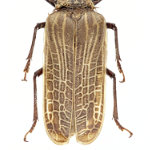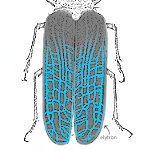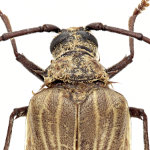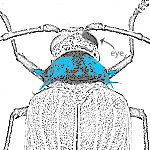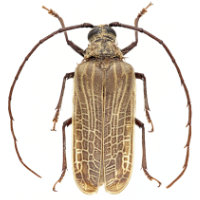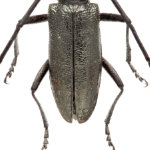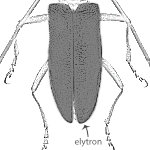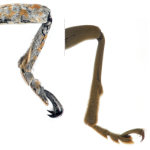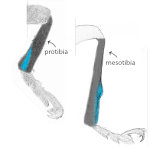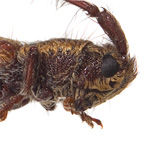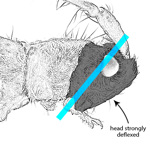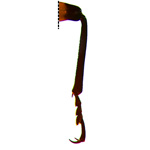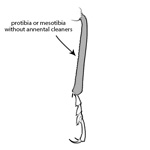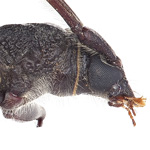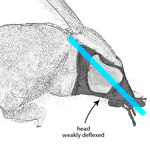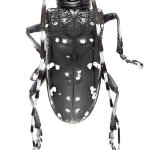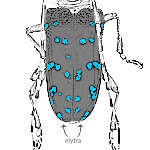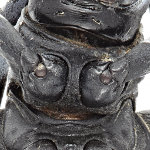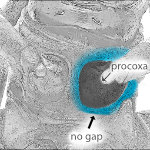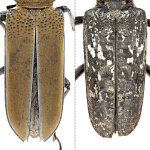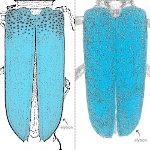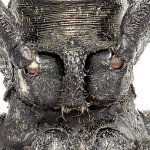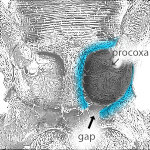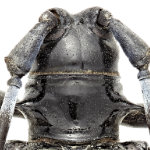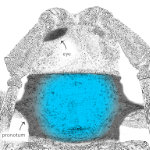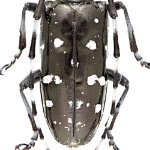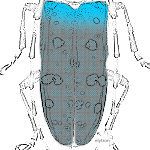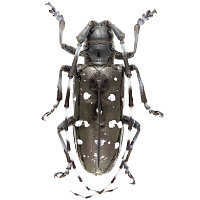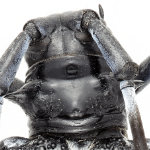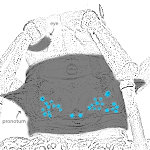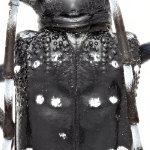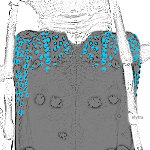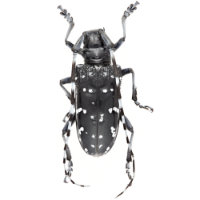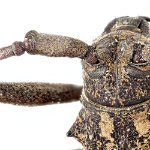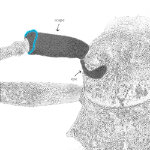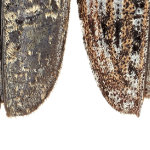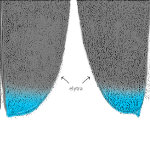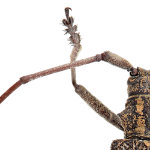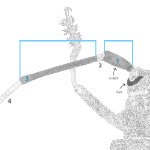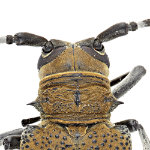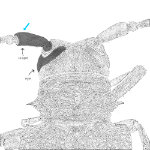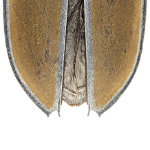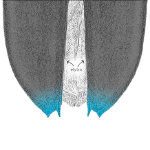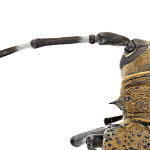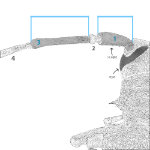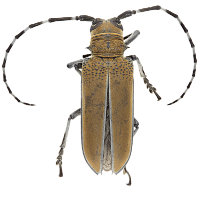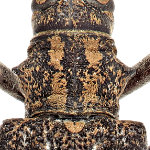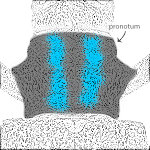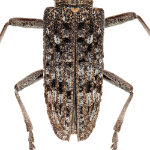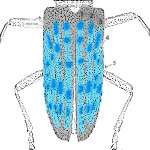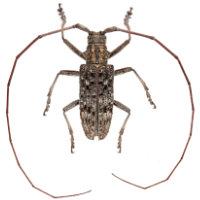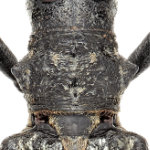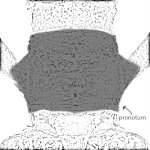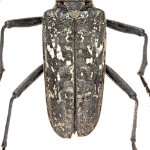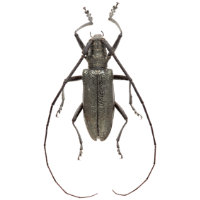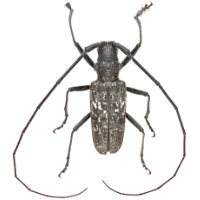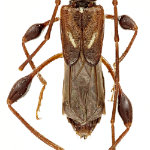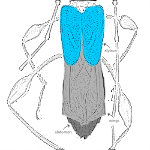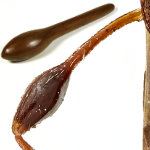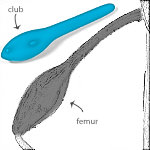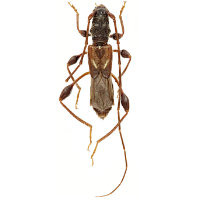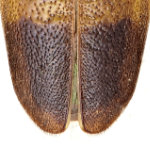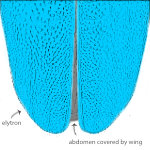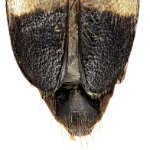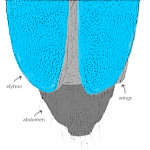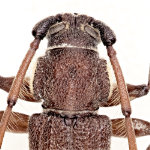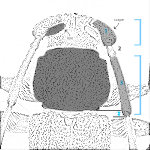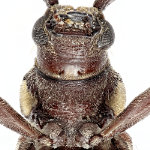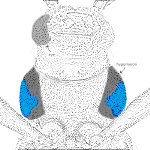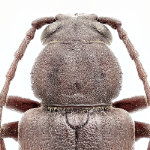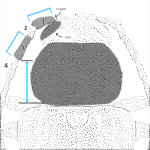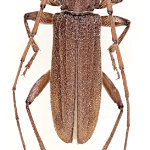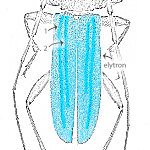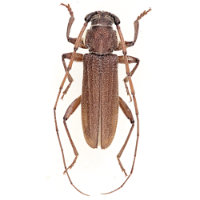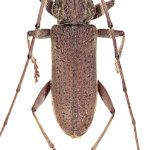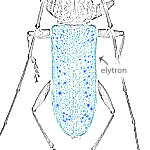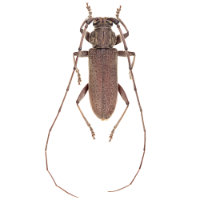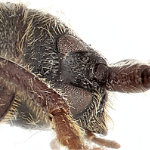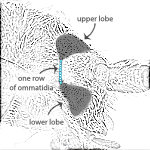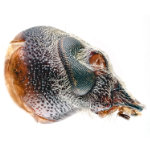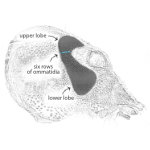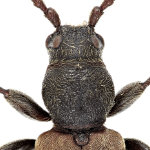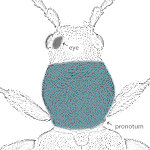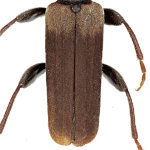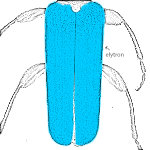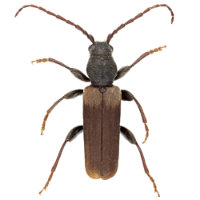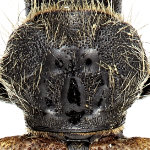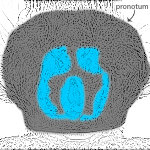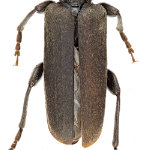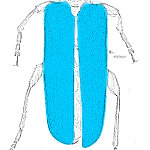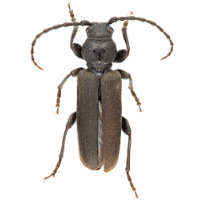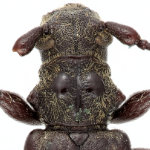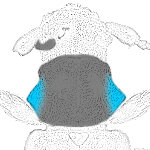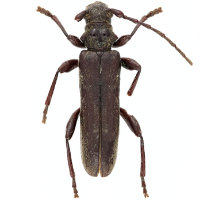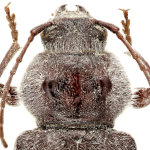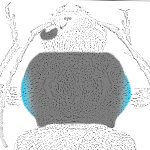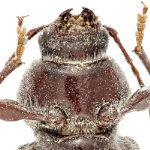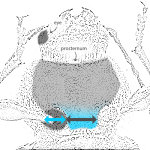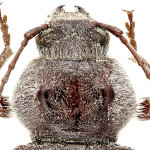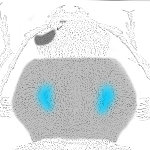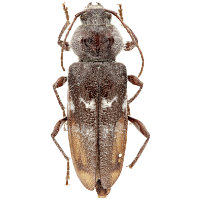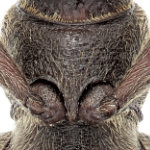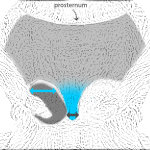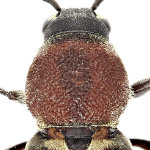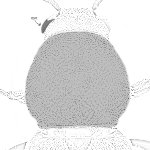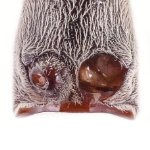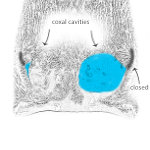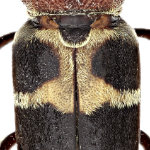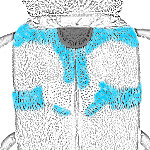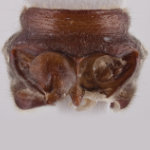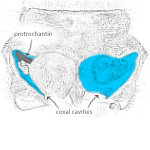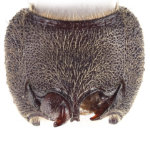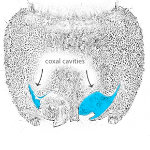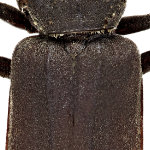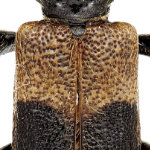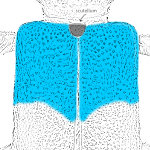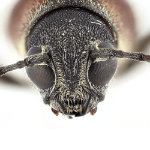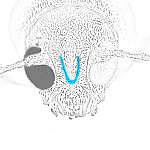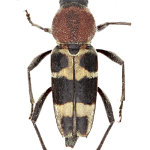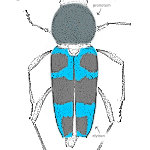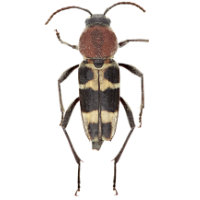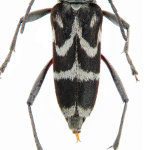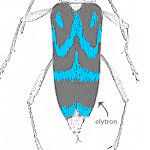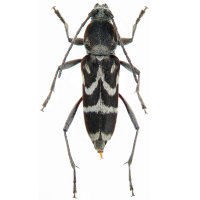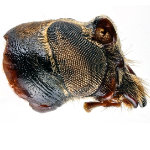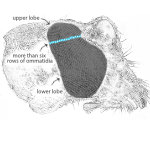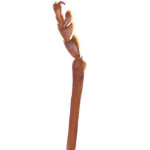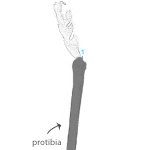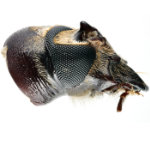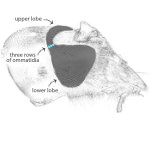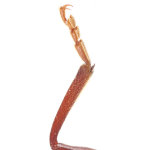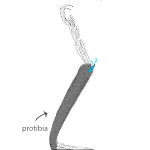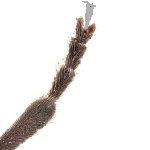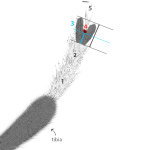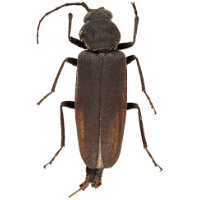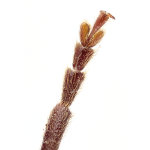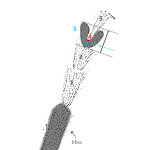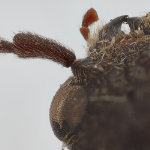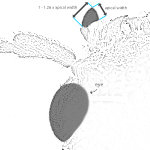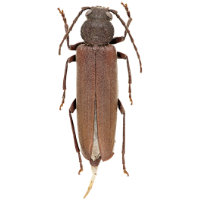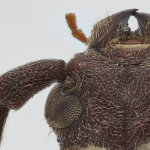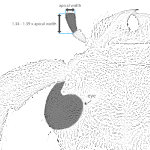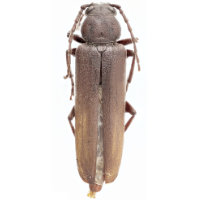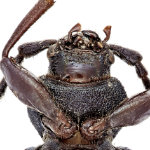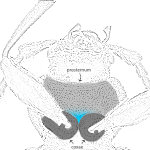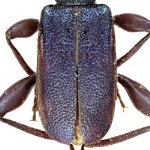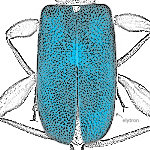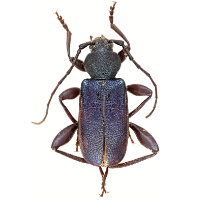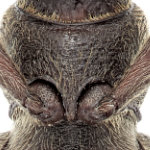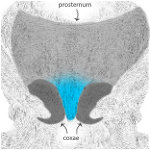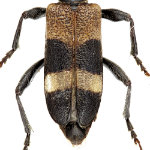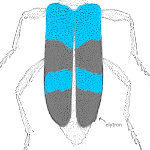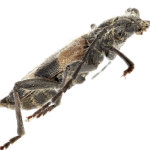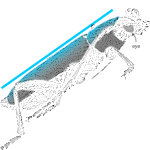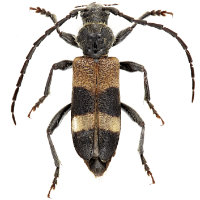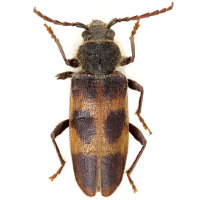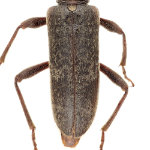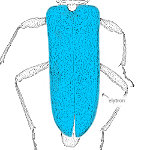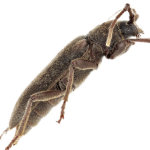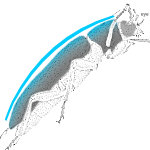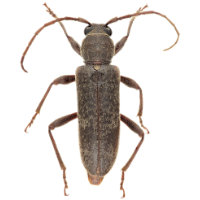Key to Cerambycidae of quarantine concern in Australia
couplet 1 of 20
Large, 30-50 mm long brown beetle; elytra with complex net-like pattern of whitish veins (Figs. 1a, 1aa); pronotum bearing sharp middle projection and dense pubescence (Figs. 1b, 1bb) . . . . . . . . . . . .
- Elytra without a net-like pattern (Figs. 1c, 1cc); size variable.
. . . . . . . . . . . . Go to couplet 2 →
couplet 2 of 20 (from 1)
Protibia with grooved antennal cleaner on inner surface (Figs. 2a, 2aa); mesotibia with sulcate or comb-like antennal cleaner on outer surface (Figs. 2a, 2aa); head strongly deflexed (Figs. 2b, 2bb).
[subfamily Lamiinae]
. . . . . . . . . . . . Go to couplet 3 →
- Protibia and mesotibia without antenna cleaners (Figs. 2c, 2cc); head prognathous or weakly deflexed (Figs. 2d, 2dd).
[subfamilies Cerambycinae and Spondylidinae]
. . . . . . . . . . . . Go to couplet 7 →
couplet 3 of 20 (from 2)
SUBFAMILY LAMINAE
Elytra bluish or black, mostly glabrous with white setae forming small isolated spots (Figs. 3a, 3aa); procoxal cavities closed posteriorly(Figs 3b, 3bb).
[genus Anoplophora]
. . . . . . . . . . . . Go to couplet 4 →
- Elytra entirely setose and of various colours and combinations (Figs. 3c, 3cc); procoxal cavities at least narrowly open posteriorly (Figs. 3d, 3dd).
. . . . . . . . . . . . Go to couplet 5 →
couplet 4 of 20 (from 3)
Pronotal disc flat (Figs. 4a, 4aa); elytra glossy black, finely punctate, smooth at basal part (Figs. 4b, 4bb) . . . . . . . . . . . .
couplet 5 of 20 (from 3)
Antennal scape with apical carina (Figs. 5a, 5aa); apices of elytra rounded or weakly angulate (Fig. 5b, 5bb); antennomere 3 very long, at least twice as long as antennal scape (Figs. 5c, 5cc).
[genus Monochamus]
. . . . . . . . . . . . Go to couplet 6 →
- Antennal scape without apical carina (Figs. 5d, 5dd); apices of elytra bispinose (Figs. 5e, 5ee); antennomere 3 moderately long, about 1.5 times as antennal scape (Figs. 5f, 5ff) . . . . . . . . . . . .
couplet 6 of 20 (from 5)
Pronotum with two longitudinal orange stripes (Figs. 6a, 6aa); each elytron with 5 longitudinal bands of black and grey rectangular spots (6b, 6bb) . . . . . . . . . . . .
couplet 7 of 20 (from 2)
SUBFAMILIES CERAMBYCINAE AND SPONDYLIDINAE
Elytra very short, not extending over abdomen (Figs. 7a, 7aa); femora strongly clavate (club-like) (Figs. 7b, 7bb) . . . . . . . . . . . .
- Elytra either completely covering abdomen (Figs. 7c, 7cc) or with only the terminal segment exposed (Figs. 7d, 7dd).
. . . . . . . . . . . . Go to couplet 8 →
couplet 8 of 20 (from 7)
Antennomere 3 very long, about 1.5 times of antennal scape, reaching beyond the posterior margin of pronotum (Figs. 8a, 8aa); male with large patch of dense yellowish setae on prothoracic hypomeron (Figs. 8b, 8bb).
[genus Stromatium]
. . . . . . . . . . . . Go to couplet 9 →
- Antennomere 3 at most slightly longer than scape and never reaching posterior margin of pronotum (Figs. 8c, 8cc).
. . . . . . . . . . . . Go to couplet 10 →
couplet 9 of 20 (from 8)
GENUS Stromatium
Elytra densely and coarsely punctate (Figs. 9a, 9aa); elytral setae sparse, partially erect and not covering rather shiny body surface (Figs. 9a, 9aa); each elytron with at least two costae (ridges) (Figs. 9a, 9aa) . . . . . . . . . . . .
- Elytral surfaces dull covered by dense and adpressed pubescence almost completely obscuring the body surface but leaving some sparse shiny granules (Figs. 9b, 9bb); elytral costae (ridges) absent or very weak (Figs. 9b, 9bb) . . . . . . . . . . . .
couplet 10 of 20 (from 8)
Eye deeply emarginate, two lobes only connected by 1 row of ommatidia (Figs. 10a, 10aa). [genus Tetropium]
. . . . . . . . . . . . Go to couplet 11 →
- Eye with two lobes connected by at least several rows of ommatidia (Figs. 10b, 10bb).
. . . . . . . . . . . . Go to couplet 12 →
couplet 11 of 20 (from 10)
Pronotum densely punctate, without any glabrous raised area (Figs. 11a, 11aa); elytra reddish or yellowish brown (Figs. 11b, 11bb) . . . . . . . . . . . .
- Pronotum weakly punctate, with 3 weak shiny, raised nodules (Figs. 11c, 11cc); elytra uniformly dark brown (Figs. 11d, 11dd) . . . . . . . . . . . .
couplet 12 of 20 (from 10)
Pronotum lateral edge with sharp median projection (Figs. 12a, 12aa) . . . . . . . . . . . .
- Pronotum with lateral edge rounded (Figs. 12b, 12bb).
. . . . . . . . . . . . Go to couplet 13 →
couplet 13 of 20 (from 12)
Prosternal process very broad, at least as wide as procoxa (Figs. 13a, 13aa); pronotum covered with dense erect pubescence, with two glabrous nodules on pronotal disk (Figs. 13b, 13bb) . . . . . . . . . . . .
- Prosternal process distinctly narrower than width of procoxa (Figs. 13c, 13cc); pronotum not covered with dense erect pubescence, without two glabrous nodules on pronotal disk (Figs. 13d, 13dd).
. . . . . . . . . . . . Go to couplet 14 →
couplet 14 of 20 (from 13)
Procoxal cavities oval, without lateral projections, not exposing protrochantin (Figs. 14a, 14aa); elytra with coloured bands formed by short adpressed setae (Figs. 14b, 14bb).
. . . . . . . . . . . . Go to couplet 15 →
- Procoxal cavities with lateral projections, at least partially exposed protrochantin (Figs. 14c, 14cc, 14d, 14dd); elytra either uniformly coloured (Figs. 14e) or with orange bands (not formed by adpressed setae) (Figs. 14f, 14ff).
. . . . . . . . . . . . Go to couplet 16 →
couplet 15 of 20 (from 14)
Frons with triangular keel (Figs. 15a, 15aa); pronotum brown with sparse yellow recumbent setae; elytra black with yellow markings (Figs. 15b, 15bb) . . . . . . . . . . . .
couplet 16 of 20 (from 14)
Eye shallowly emarginate (Figs. 16a, 16aa); Protibial spur single (Figs. 16b, 16bb). [genus Arhophalus]
. . . . . . . . . . . . Go to couplet 17 →
- Eye distinctly emarginate (Figs. 16c, 15cc); Protibial spurs paired (Figs. 16d, 16dd).
. . . . . . . . . . . . Go to couplet 19 →
couplet 17 of 20 (from 16)
Articulation of tarsomere 4 with tarsomere 3 (or point of division into two lobes of tarsomere 3) is about halfway along the total length of tarsomere 3 (Figs. 17a, 17aa) . . . . . . . . . . . .
- Articulation of tarsomere 4 with tarsomere 3 (or point of division into two lobes of tarsomere 3) is fairly close to the base of tarsomere 3 (Figs. 17b, 17bb).
. . . . . . . . . . . . Go to couplet 18 →
couplet 18 of 20 (from 17)
Terminal segment of maxillary palp strongly securifrom, with length 1-1.26 times its apical width (Figs. 18a, 18aa) . . . . . . . . . . . .
couplet 19 of 20 (from 16)
Prosternal process very narrow, incomplete between procoxae (Figs. 19a, 19aa); elytra with iridescent colours (Figs. 19b, 19bb) . . . . . . . . . . . .
- Prosternal process narrow, but always complete between procoxae (Figs. 19c, 19cc); elytra without iridescent colours.
. . . . . . . . . . . . Go to couplet 20 →
couplet 20 of 20 (from 19)
Elytra with orange markings (Figs. 20a, 20aa); body distinctly flattened (Figs. 20b, 20bb) . . . . . . . . . . . .
